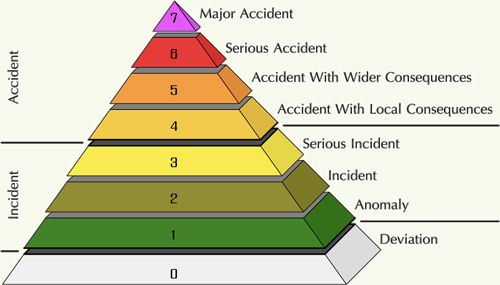The severity scale of nuclear accidents

The INES scale
The severity of radioactive releases is assessed using a scale similar to the Richter scale used for earthquakes. This scale, called INES (International Nuclear Event Scale) has 7 levels. The Chernobyl accident, which occurred in 1986 before its institution, would have been classified at level 7, as the 2011 Fukushima accident, while that of 1978 Three Mile Island would have been classified at level 5.
© Wikipedia
Nuclear installations and their operation are complex and difficult to grasp for journalists and the public as well. When an incident is announced, sometimes a simple water leak, criteria were lacking to assess its severity. This is why, France and the international community, have designed a “scale” of nuclear incidents similar to the model built for earthquakes.

Classification of serious accidents
Diagram of accidents levels 4 to 7 on the INES scale. Three criteria related to safety are taken into account for the classification: the consequences for the environment (off-site impacts), the installations (impacts on the site) and for the degradation of defense in depth (impacts on the safety barriers). The three most serious nuclear accidents were classified at level 7 (Chernobyl and Fukushima) and 5 (Three Mile Island).
© EDF
The INES scale (International Nuclear Event Scale), set up in 1991, is graduated from 0 to 7. It defines the relative gravity of an event and characterizes it. It is a benchmark and an information tool for the media and the public. The classification on this scale takes into account 3 criteria: the environmental consequences, the impact on the site and the degradation of the defense in depth. Levels 4 to 7 concern accidents, levels 1 to 3 anomalies and incidents.

Classification of incidents and anomalies
Diagram describing levels 0 to 3 of the INES scale (International Nuclear Event Scale), corresponding to incidents and anomalies. For each, the consequences for the environment (off-site impacts), the installations (impacts on the site) and for the degradation of defense in depth (impacts on security barriers) are indicated.
EDF
1 : Consequences on the environment: levels 1 and 2 concern incidents without consequences on the environment. The events leading to a radioactive release range from level 3 (low release) to level 7 (major release). Level 5 indicates an accident presenting risks outside the site; levels 6 and 7 represents a major release. The Chernobyl accident (1986) was classified at level 7 (maximum) because of its consequences on the environment and the exposures suffered by the populations. The 2011 Fukushima accident was also classified at level 7 due to the vast contaminated territories despite the probable absence of significant health consequences.
2 : The impact on the site, that is to say the damage suffered by the installations, the containment barriers or the personnel exposure to radioactivity. In the absence of significant releases of radioactivity to the environment, the levels range from 2 to 5. We speak of an “accident” from level 4. The most serious accident, classified at level 5, was that of Three Mile Island (1979) for which there was a core melting, but no incidence outside power plant.
3 : Degradation or failure of defense in depth: this criterion allows to assess the direct or potential consequences of the event on safety functions (fuel cooling, confinement of radioactivity) and on the quality of available defense lines . Such events are classified from level 1 to level 3, but have no impact on the environment or the site.
Events that are of no or little importance to safety are called « anomalies »; they are classified at level 1 or 0. Events not relevant to safety are said to be “below scale”.
Since the creation of the INES scale (after Chernobyl), the world has had to classify one event at the level 7, that of Fukushima. On the other hand, there are each year events which are classified at levels 1 and 2, essentially foor degradation of the defense in depth. In France, the level is proposed by the nuclear power operator, then confirmed, or even revised, by the Nuclear Safety Agency.
Other articles on the subject « Nuclear Accidents »
Accidents of radioactivity
The importance of a close monitoring of radioactive sources… In many countries, the possess[...]
Accident Causes
Human errors, design flaws and natural cataclysms A nuclear accident dwarfs all other types of ac[...]
Mayak Accident
A military long-hidden nuclear accident of the Soviet era Long before Chernobyl, it was suspected[...]
Windscale Accident
Windscale : an accident of the U.K nuclear weapon program (1957) The fire which occurred the 10th[...]
Three Mile Island
1979: A major accident that led to the destruction of a reactor The Three Mile Island plant (TMI)[...]
Tokaimura Accident
1999 : a « criticity » accident in Japan This surprising accident of « criticality » came about i[...]